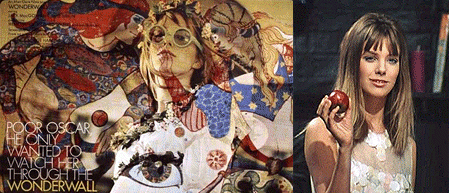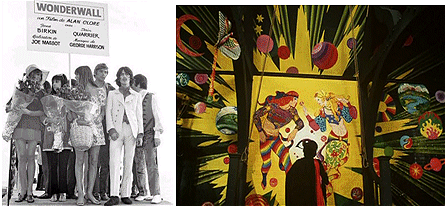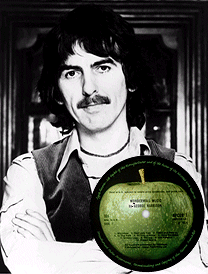Sixties
City presents
a wide-ranging series of
articles on all aspects of the Sixties, penned by the creator of the iconic
60s music paper Mersey
Beat
|
Sixties
City presents
a wide-ranging series of
articles on all aspects of the Sixties, penned by the creator of the iconic
60s music paper Mersey
Beat
|
|||||
|
 |
George
Harrison provided the music for the sound of this film, directed by Joe
Massot and starring Jane Birkin, Jack MacGowran and Iain Quarrier. Oscar
Collins, a scientist who works for the water board, accidentally creates
a hole in his wall and watches a young model and her photographer boyfriend
who live next door, a plot not unlike the Henry Barbousse novel ‘L’Enfer’.
The Dutch design group The Fool also provided the set designs for the
film. ‘Wonderwall’ was premiered at the Cannes Film Festival on May 17th
1968 with George and Patti Harrison and Ringo and Maureen Starkey in attendance.
The British release was on January 12th 1969. The movie soundtrack album was said to have made George the first member of The Beatles to compose a complete soundtrack for a film (although Paul had been involved in soundtrack work on ‘The Family Way’ two years previously). The soundtrack was issued under George’s name, although he only composed and produced and didn’t play on any of the tracks. He was initially asked to become involved in composing the soundtrack by director Joe Massott in 1967, although Massott had originally approached The Bee Gees, who declined the project. George began work on it after the ‘Magical Mystery Tour’ in late 1967, deciding on an instrumental soundtrack and produced a series of home demos after viewing an unfinished version of the film. Massot was to say, “I had various choices, The Bee Gees were interested in doing something and came to Twickenham Studios to see me. It seemed the movie had created a vibe as Graham Nash also wanted to join in. George told me that he had been working on "Magical Mystery Tour" helping out, but that was Paul's project...that he would like to do something solo. So I told him he would have a free hand to do anything he liked musically. That was what interested him in the picture". George then gathered a number of musicians using Abbey Road and the De Lane Lea Recording Studio in Kingsway. He produced two numbers in Abbey Road’s Studio 2 on Wednesday November 22nd 1967 under the working titles ‘India’ and ‘Swordfencing,’ utilising the talents of two flautists Richard Adeney and Jack Ellory, together with a tabla player. |
 |
The following
day he was recording in Studio 3 and the musicians used included two oboists,
one trumpeter and two flautists. The complete personnel of musicians at
the various London sessions were: John Barham, piano, flugelhorn; Tommy
Reilly, harmonica; Colin Manley, guitar, steel guitar; Tony Ashton, jangle
piano, organ; Phil Rogers, bass; Roy Dyke, drums. He recorded another session
at Abbey Road’s No 2 studio on January 5th and on January 7th 1968. George flew to India and spent five days at the EMI Studios in Bombay. Musicians at the Bombay sessions included: Ashish Khan, sarod; Mahapurush Mistra, tabla, pakavaj; Sharod and Hanuman Jadev, shanghais; Sambu-Das, Indril Bhattacharya, Shankar Ghosh, sitars; Chandra Shakher, surbahar; Shiv Kumar Shermar, santoor; S.R. Kenkare, flute; Vanaik Vora, thar-shanhai, Rij Ram Desad, harmonium, Tablatarang. The album became the first LP released on the Apple label on Friday November 1st 1968 on Apple SAPCOR 1 and in America on December 2nd 1968 on Apple ST 3350 where it reached No.49 in the charts. The tracks were: Side One: ‘Microbes’, ‘Red Lady Too’, ‘Tabla and Pakavaj’, ‘in the Park’, ‘Drilling A Home’, ‘Guru Vandana’, ‘Greasy Legs’, ‘Ski-ing’, ‘Gat Kirwani’, ‘Dream Scene.’ Side Two: ‘Party Secombe’, ‘Love Scene’, ‘Crying’, ‘Cowboy Music’, ‘Fantasy Sequins’, ‘On the Bed’, ‘Glass Box’, ‘Wonderwall To Be Here’, ‘Singing Om.’ The press synopsis for the film read: “In 1960’s London an eccentric professor (Jack MacGowran) lives the life of a recluse. He becomes fixated with a beautiful model Penny Lane (Jane Birkin), the girlfriend of Svengali-like fashion photographer (Iain Quarrier). The professor spies on the girl through a hole in the wall in his gothic flat, and embarks on a quixotic quest to become her champion. The kaleidoscope of images and George Harrison’s musical score catapult the audience into another realm of consciousness." |
 |
|
Article
Text
UK
web hosting by
|